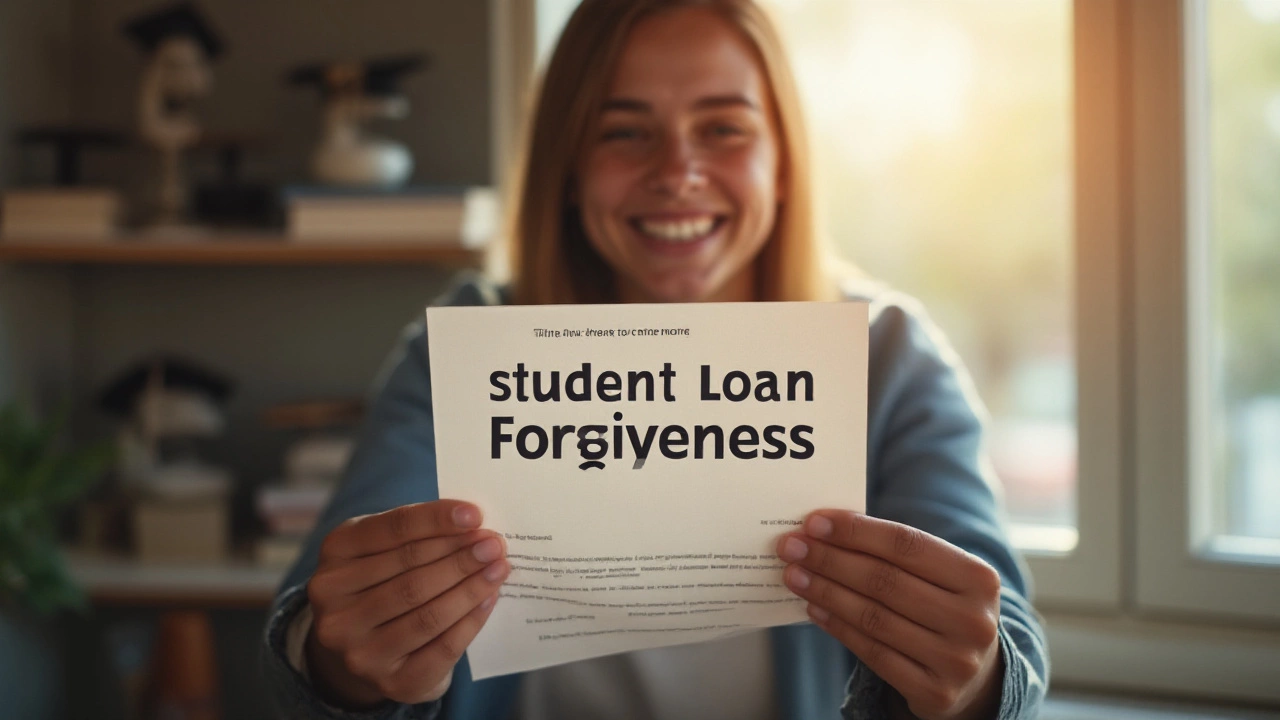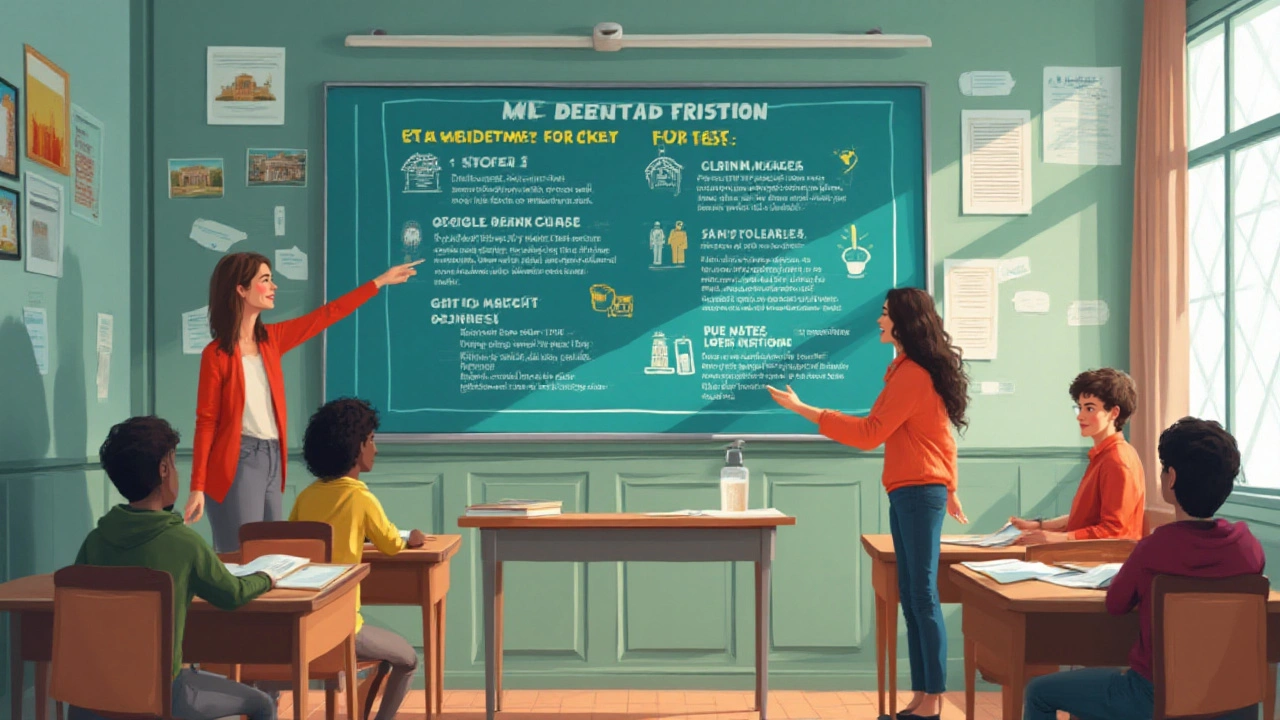Will My Student Loan Be Forgiven? Signs, Programs, and What to Do Next
 Aug, 2 2025
Aug, 2 2025
Last year, social media was going wild with people celebrating student loan forgiveness. But there you are, staring at your own loan account, unsure if you’re next… or stuck paying until your hair goes grey. The headlines scream about government programs wiping balances, but the letters you get from the National Student Loans Service Centre just leave you confused. What separates the lucky few from the ones still writing cheques? And will your own student loan disappear, or is that just wishful thinking?
What It Really Takes to Qualify for Student Loan Forgiveness
The word “forgiveness” gets thrown around in advice columns and TikTok videos like it’s some free pass for everyone. Here’s the hard truth: the rules for actual student loan forgiveness in Canada (and the U.S., if you’re reading from across the border) are complicated, and most people don’t actually qualify. Let's look at what counts.
In Canada, the main type of broad forgiveness comes through government programs. Ontario, for example, had the Ontario Student Assistance Program (OSAP) give out grants to cover chunks of tuition, but most loans are still federal—which means you deal with the National Student Loans Service Centre (NSLSC). The federal government has wiped out billions through Repayment Assistance Plan (RAP) and the Severe Permanent Disability Benefit, but there’s no sweeping forgiveness for everyone yet.
Here’s where it gets nitty-gritty. For the vast majority, the only forgiveness options are:
- Repayment Assistance Plan (RAP): If you can’t afford the monthly payments, after a certain number of years (typically 15), any remaining loan may be forgiven. But it’s not a guarantee—you have to reapply often and prove your income stays low.
- Severe Permanent Disability Benefit: If you are unable to ever work again, and your doctor agrees, your federal and provincial loans can be discharged.
- Death: If you pass away, your student loan balance is wiped. Not exactly a positive outcome, but it’s there.
- Specific Professions: Nurses and doctors working in remote places can sometimes get part of their loan forgiven. It’s usually a small group who qualify, and you’ll need documentation.
There are no official student loan bankruptcy options in Canada for government-backed loans until 7 years after you stop being a full-time student. Private loans, like those from banks, have different rules entirely. The U.S. system is a mess of programs (PSLF, Income-Driven Repayment) with their own hoops. Plenty of folks have made costly mistakes assuming their loans would vanish. Awareness matters more than hope.

How to Check If You’re On Track for Forgiveness
You’d think the government would make it crystal clear if you were headed for student loan forgiveness, but that’s rarely the case. There’s no “forgiveness meter” when you log into NSLSC. So, how do you know if your loan is actually heading toward being wiped out, or you’re just floating along?
Here’s the step-by-step way to see if you’re eligible:
- Log In to Your Account: Start at the NSLSC online portal. Your dashboard will spell out if you’re on any repayment plan, dates of payments, and status. If you see the words “Repayment Assistance Plan,” that’s your first sign.
- Look for Paperwork: Check recent emails or mail from NSLSC. If you’re enrolled in disability forgiveness, you’ll have stacks of medical paperwork signed by your doctor and Service Canada. For special profession forgiveness, you’ll get a contract or commitment letter from your employer and the government.
- Track Eligibility Period: RAP only erases your debt after you’ve faithfully reapplied and paid what you can for up to 15 years. Double-check your start date; not every year you’re in school or in deferment counts.
- Verify Your Income: For income-driven plans, you need fresh proof of income every year. Miss a deadline and you get booted off, so set reminders.
- Find Out Which Program You Have: Some provinces run their own mini-programs. For instance, Nova Scotia and British Columbia have partial forgiveness for staying and working locally. Visit your province’s student loan site for fine print.
- Call the Service Centre: Yes, you’ll wait on hold, but sometimes talking to a real person is the best way. Ask, "What would it take to qualify for forgiveness? Am I on track?" They’ll pull up your record and spell out exactly what’s missing, if anything.
Don’t just assume silence means good news. Miss a step, forget to reapply, or fail to update info, and your status resets. Real story: I once forgot to re-upload an income notice for RAP. Next bill tripled. Ouch.
Here’s a quick stat table on repayment assistance in Canada as of 2024:
| Program | Number of People Assisted | Typical Forgiveness Period |
|---|---|---|
| Repayment Assistance Plan (RAP) | ~360,000 per year | 15 years |
| Severe Permanent Disability Benefit | ~3,000 per year | Immediate on approval |
| Profession-Specific (nurses/doctors) | ~1,500 per year | 2-5 years |
Seeing numbers like that brings it home. Most folks in repayment assistance still carry their loans for years before any balance is forgiven. Compare that to the millions holding student debt across Canada.

Smart Moves to Maximize Your Forgiveness Chances
This isn’t a game you want to play blindfolded. If you really want to position yourself for *student loan forgiveness*, you’ve got to work the system. Think proactive, not passive. Here’s how you can be ahead of the curve:
- Apply for Repayment Help Immediately: If you’re even a month late on a payment, don’t wait for trouble. Hit the NSLSC and fill out the Repayment Assistance Plan app. Even if you don’t qualify now, you might in a few months.
- Automate Everything: Set calendar reminders, go paperless, and use online banking. A single missed annual re-application can set you back years on the forgiveness clock.
- Document Everything: Screenshot every confirmation message, save PDF copies of all RAP/RAFT approvals, and keep a physical folder if you have to. Bureaucracy loves paperwork.
- Know Your Province: Each province has little-known tweaks to federal loans. Alberta dumps some loan interest. Nova Scotia cuts a chunk off if you stay in the province. Spend 20 minutes reading your province’s loan office site; it could mean thousands.
- Don’t Ignore Tax Time: Sometimes your Notice of Assessment gets lost, and the government can boot you from RAP if you don’t file taxes. Keep your taxes up to date.
- Get It In Writing: Whenever someone at NSLSC or your provincial office tells you something—especially about forgiveness—ask for it in writing, via email. Never rely on a phone call memory.
- Follow the News: Student loan news changes fast. In 2022, zero interest federally became permanent. In 2023, they raised RAP income thresholds. This stuff directly impacts your bottom line.
- Don’t Trust Viral Stories: If it sounds too good to be true, it probably is. Government forgiveness programs move slow and don’t send sudden cheques in the mail.
- Repayment Is Still an Option: If forgiveness looks impossible, pay off aggressively when you can scrape together extra. No interest on federal loans (as of 2024) means every dollar hits principal.
- Don’t Panic About Credit: As long as you’re in good standing or in RAP, your credit stays safe. If you default, that’s when real trouble starts—think wage garnishment, ruined scores, and nights spent Googling bankruptcy law.
My own story: I set up autopay, apply for RAP every year, and keep a YouTube playlist reminding me of deadlines (Everett, my eight-year-old son, makes the reminders impossible to ignore). Being organized doesn’t just help, it’s a survival skill if you want a shot at ever seeing your balance hit zero without breaking the bank.
One last kicker: ask around. Some of the best advice comes from recent grads at your work or in your friend group who’ve actually gone through forgiveness. They’ll spill the real stuff—the tricks, the red tape, and the honest odds. Half my neighbours in Toronto are juggling their own student loan drama, and swapping stories can save you years of headaches.
It’s tempting to hope your student loan will just vanish. But between government rules, surprise paperwork, and the yearly ritual of reapplying, forgiveness isn’t just about waiting. Take the reins, track your steps, and you might see that magical zero on your balance someday. Just don’t leave it up to luck.
